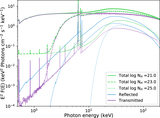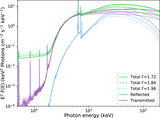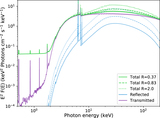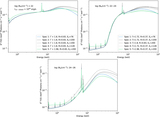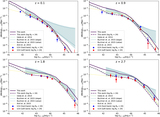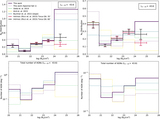Image Details
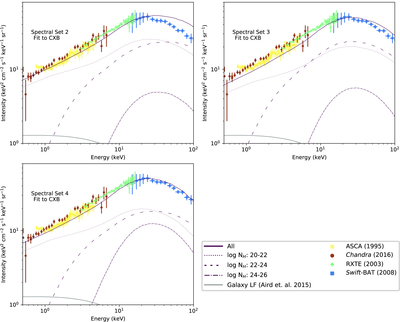
Caption: Figure 8.
CXB data points fitted with three different assumed AGN spectra. Top left panel: the assumed spectra are from Spectral Set 2 from Table 4. Unabsorbed AGNs (dotted line) dominate the E < 1 keV region, so we fix the unabsorbed fraction such that this region is well fitted. Changing the unabsorbed contribution will over- or underproduce the CXB in this region. The Compton-thin objects (dashed line) contribute heavily in the 3–10 keV region, where the CXB is underestimated by ≥3σ with respect to RXTE data. Increasing the Compton-thin contribution will improve the fit in this region but overestimate the CXB at >30 keV, even with a negligible contribution from Compton-thick objects (dotted-dashed line). Increasing the Compton-thick fraction will contribute minimally in the 3−10 keV region but will lead to greater overestimation at higher energies, as the Compton-thick contribution peaks at 20–60 keV. The black solid lines in all three panels show the galaxy contribution to the CXB, calculated using the A15 galaxy LF. Top right panel: Spectral Set 3 adopts a higher photon index (1.8) and reflection coefficient (0.87) for absorbed objects, equal to those of unabsorbed objects. This model reaches better agreement with the CXB than Spectral Set 2 at E > 30 keV but continues to overestimate it, and it does not match all observed constraints. Bottom left panel: Spectral Set 4 adopts the same reflection parameter and photon index distributions as Spectral Set 2, but a lower cutoff energy of 128 ± 46 keV. It produces improved (but not perfect) fits to the CXB compared to Spectral Sets 2 and 3 but heavily underestimates Compton-thick number counts and fractions, as a higher Compton-thick contribution will overproduce the CXB at E > 30 keV.
Copyright and Terms & Conditions
© 2019. The American Astronomical Society. All rights reserved.



